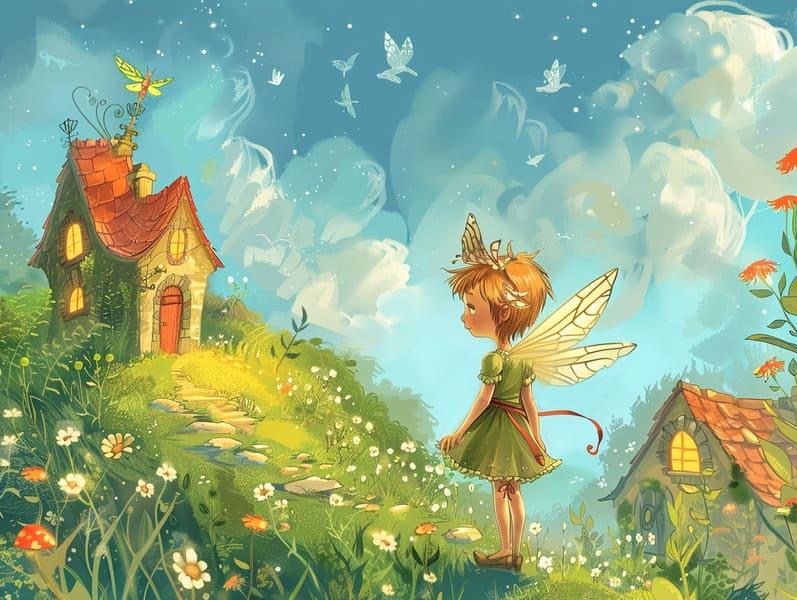
Children's fairy tales have ancient roots. These stories have been transmitted from one generation to the next far before they were ever recorded. They originated from a variety of traditions, including Indigenous traditions. They were initially conveyed among grown-ups, often carrying themes and messages pertaining to the societal norms and beliefs of the time.
The famous Grimm duo, Jacob and Wilhelm (the Grimm brothers), were among the first to compile and release many of these beloved fairy tales. Their published works, "Grimm's Fables," included stories like "The Story of Cinderella," "Little Brother and Little Sister," and "Schneewittchen," which have since become cornerstones in the world of classic fairy tales. Similarly, Hans Andersen's enchanting narratives, such as "The Little Mermaid," and "The Duckling that Could," have touched hearts worldwide, guaranteeing their place in the pantheon of beloved fairy tales.
Though they are centuries old, traditional fairy tales remain as impactful as ever, especially as children's bedtime stories. These enchanting tales are now available in different formats, including colorful picture books, captivating animations, and digital fairy tales.
Their lasting presence can be attributed to several magical reasons:
Crucial Morals: Timeless fairy tales often teach important moral lessons. Narratives like "The Wolf and the Liar" teach the value of being truthful, while "The Race of the Tortoise and the Hare" illustrate the benefits of steadfastness and humbleness. These stories offer kids clear distinctions between moral and immoral, forming their moral compass in a mild yet deep way.
Warmth and Understanding: Timeless fairy tales frequently involve beings facing obstacles and hardships, inciting kids to relate with their struggles and boost their triumphs. For instance, "Beauty and the Beast" shows us the importance of looking past the exterior to acknowledge the true essence of a soul, fostering warmth and insight.
Cultural Awareness: Many fairy tales are steeped in the cultural contexts from which they originated. Reading these tales can provide captivating looks into different cultures, promoting a sense of world appreciation and awareness.
Inventiveness and Fantasy: The fantasy-filled elements in fairy tales—fairy godmothers—fuel children’s dreaming abilities. These narratives bring readers to enchanted realms, generating imaginative thinking and a sense of wonder that persists a lifetime.
Classic fairy tales are not only delightful but also didactic. They work as enchanted tools in nurturing various brain and heart skills in little ones. When old fairy tales are voiced, they foster language development by bringing new terms and meanings and detailed sentence structures. This practice also improves auditory perception and mental focus, as little ones follow the story, anxious to see what happens next.
Furthermore, analyzing the themes and characters of ancient fairy tales can promote reasoning skills and logical thinking. The young are led to identify patterns, make predictions, and grasp cause and effect. These debates also assist young readers articulate their thoughts and feelings, enhancing their emotional intelligence.
In today’s digital age, the abundance of online fairy tales has made these narratives more acquirable than ever. Digital sites and online apps share extensive collections of ancient fairy tales that can be enjoyed or listened via anytime, anywhere. Fairy tales spoken are particularly sought after, extending an charming way for young readers to experience these entrancing tales. Read-aloud stories and read-to-me videos transport characters and settings to life, often enhanced by fantastical sound effects and background music that boost the narrative adventure.
The lasting allure of classic fairy tales lies in their ability to adapt to today's society while retaining their underlying messages. Contemporary reinterpretations of these stories often spotlight more different protagonists and modern settings, making them relevant to today’s audience. However, the underlying themes of daring, warmth, and equity remain unchanged, continuing to reach young listeners of all ages.
Timeless fairy tales also offer a sense of calm and comprehensibility. They afford a well-structured narrative with a definite beginning, middle, and end, often ending with the closure of conflicts and the triumph of virtue over wickedness. This dependability can be solacing for children, providing a sense of firmness in an fluid world.
Traditional fairy tales continue to bewitch and check it out educate new generations, maintaining their splendor and meaningfulness in modern society. As children's night stories, they feature a perfect blend of fantasy and learning, cultivating moral values, empathy, and creativity. The abundance of digital storybooks and the popularity of fairy tales recited warrant that these timeless stories remain obtainable to new generations.
By continuing and conveying these narratives, we continue to praise the rich tapestry of mythology and cultural heritage. Whether you are exploring a artistically illustrated book, seeing a online collection, or listening on an voice book, the grandeur of classic fairy tales is always within reach. These narratives demonstrate of the everlasting effect of fairy tales and its ability to draw us together across time and space.
Whether you are delving into a beautifully illustrated book, discovering a virtual library, or playing an voice book, the delight of popular fairy tales is always within reach.
These tales emphasize of the invariable influence of stories and its ability to bond us across eras and regions, making a tie that charms and informs alike.